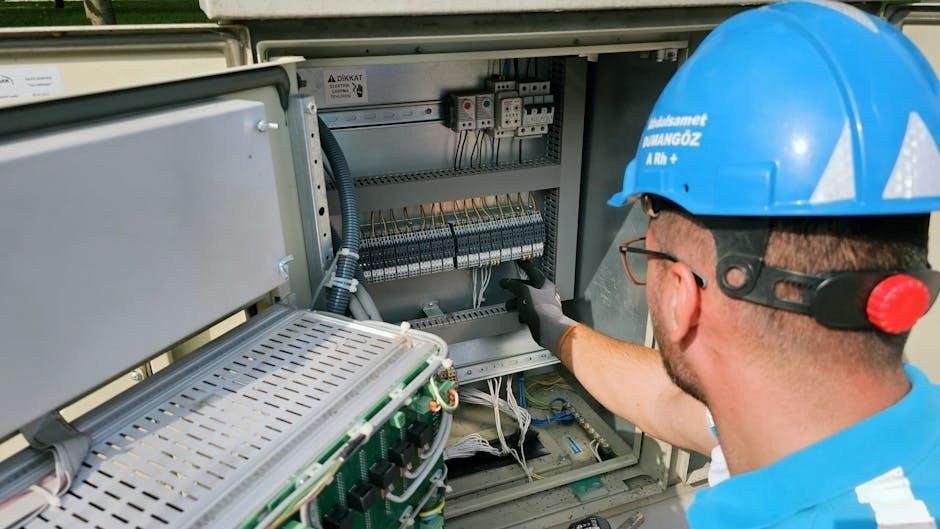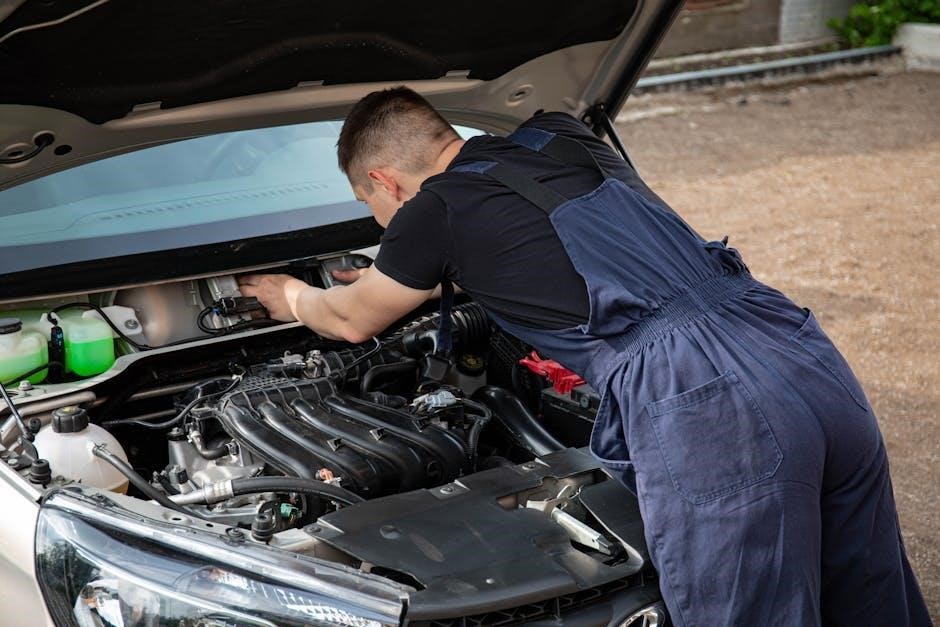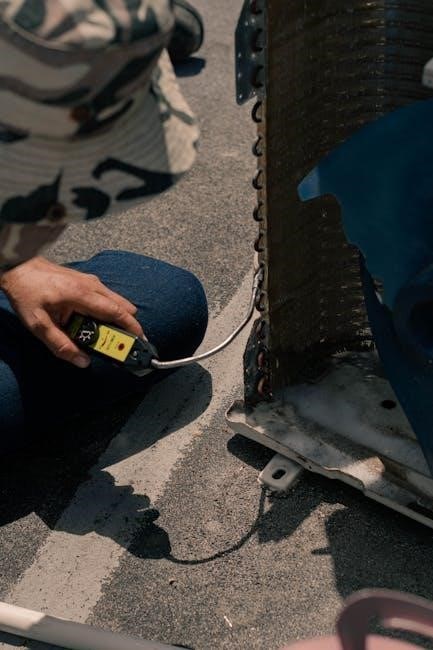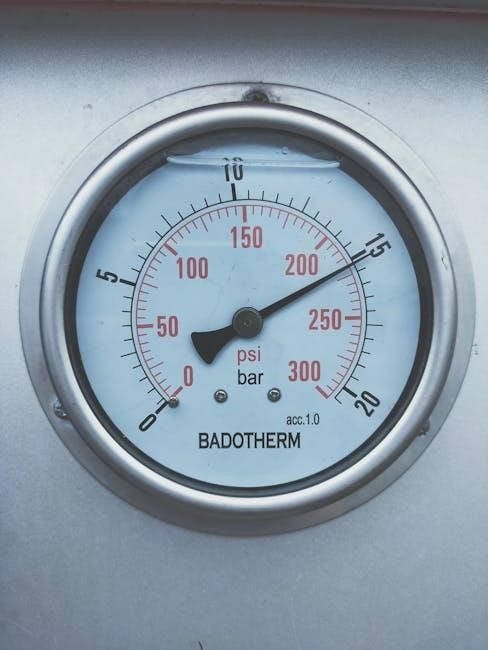The Veeder-Root TLS-350 is a state-of-the-art volumetric line leak detector designed for accurate fuel measurement and leak detection in petroleum storage systems, ensuring environmental compliance and operational safety.
1.1 Overview of the TLS-350 System
The TLS-350 is a comprehensive volumetric line leak detection system designed for petroleum storage applications. It integrates advanced sensors, real-time monitoring, and automated alerts to ensure precise fuel measurement and leak detection. The system is built for reliability, offering intuitive operation and robust performance in various environments. Its modular design allows for easy integration with existing infrastructure, making it a versatile solution for gas stations, terminals, and industrial sites. Regular updates and maintenance ensure optimal functionality and compliance with safety standards.
1.2 Importance of Troubleshooting
Troubleshooting the Veeder-Root TLS-350 is critical for maintaining system accuracy, preventing environmental hazards, and ensuring compliance with regulations. Prompt identification of issues minimizes downtime, reduces financial losses, and avoids potential legal repercussions; Regular troubleshooting also extends the system’s lifespan and ensures reliable performance in fuel measurement and leak detection. By addressing problems early, users can prevent escalation and maintain operational efficiency, safeguarding both the environment and business continuity.

System Components and Architecture
The TLS-350 system comprises a console, tank probes, and communication modules. It operates on specialized software and firmware, enabling precise fuel measurement and leak detection management.
2.1 Key Hardware Components
The TLS-350 system includes a central console, tank probes, and communication modules. The console serves as the control center, while tank probes monitor fuel levels and detect leaks. Communication modules ensure data transmission between components. Additional hardware includes the ISD System, DIM cards, and a filter basket for maintaining system integrity. Each component is essential for accurate measurement and reliable operation, requiring proper installation and maintenance to ensure optimal performance and compliance with safety standards.
2.2 Software and Firmware Overview
The TLS-350 operates on specialized software designed for fuel measurement and leak detection. The system’s firmware ensures accurate data processing and communication between hardware components. Regular updates are essential to maintain functionality and security. The software includes diagnostic tools for troubleshooting and supports advanced features like pressure integrity tests. Proper installation and configuration of both software and firmware are critical for optimal system performance and compliance with safety standards.

Common Issues and Error Codes
The TLS-350 often encounters issues like communication errors, sensor malfunctions, and pressure integrity test failures. Error codes help identify root causes, ensuring timely resolution and system reliability.
3.1 Understanding Alarm Codes
Alarm codes on the Veeder-Root TLS-350 are critical for diagnosing system issues. Each code represents specific faults, such as sensor failures or communication errors. Understanding these codes is essential for quick troubleshooting. Referencing the manual, users can identify root causes, like faulty probes or network issues. Addressing these codes promptly ensures operational continuity and prevents potential risks. Regular code monitoring helps maintain system integrity and compliance with safety standards.
3.2 Identifying System Faults
Identifying system faults on the Veeder-Root TLS-350 involves analyzing alarm codes, diagnostic logs, and physical system inspections. Common faults include sensor malfunctions, communication errors, or software glitches. Users can utilize diagnostic tools to pinpoint issues, such as running pressure integrity tests or checking probe connectivity. Regular system checks and log reviews help detect potential faults early, ensuring timely resolutions and preventing downtime. Always refer to the troubleshooting manual for detailed fault identification procedures.

Troubleshooting the Console
Troubleshooting the TLS-350 console involves diagnosing display issues, resolving communication errors, and ensuring proper system configurations. Regular checks help maintain optimal performance and functionality.
4.1 Diagnosing Console Display Issues
Diagnosing console display issues involves checking for power supply, loose connections, and screen damage. Ensure the console is properly powered and cables are securely connected. If the display is blank or flickering, restart the system or reset it. Clean the screen gently to remove debris. Consult the troubleshooting manual for specific error codes related to display malfunctions. Addressing these issues promptly ensures reliable operation and accurate readings.
4.2 Resolving Communication Errors
Communication errors in the Veeder-Root TLS-350 often stem from faulty connections or misconfigured settings. Begin by verifying all cables are securely connected and IP settings are correctly configured. Restart the console and ensure network compatibility. Check for firmware updates and install them if necessary. Use diagnostic tools to identify specific issues. If problems persist, consult the troubleshooting manual for advanced solutions to restore seamless communication and system functionality.

Tank Probe and Sensor Troubleshooting
Identify and resolve issues with tank probes and sensors by checking connections, verifying sensor accuracy, and performing pressure integrity tests to ensure reliable data collection and system performance.
5.1 Checking Probe Connectivity
Inspect the probe cables and connections for damage or corrosion. Ensure all connectors are securely attached and free from debris. Refer to the manual for specific procedures to verify probe communication with the console. Tighten any loose screws and check for proper grounding. If issues persist, consider replacing worn or damaged components. After repairs, rerun the pressure integrity test to confirm system functionality and accurate data transmission.
5.2 Calibrating Sensors for Accuracy
Calibration ensures precise measurements and reliable data from the TLS-350 system. Use the manufacturer-provided calibration tools or software to adjust sensor settings. Refer to the manual for step-by-step instructions. After calibration, run a pressure integrity test to verify accuracy. If calibration fails, repeat the process or contact technical support for assistance. Proper calibration is critical for maintaining system performance and compliance with regulatory standards.
Software and Firmware Troubleshooting
Resolving software issues and updating firmware ensures optimal system performance. Address configuration errors and use diagnostic tools to identify and fix problems promptly, minimizing downtime and data loss.
6.1 Updating Firmware Safely
Updating the TLS-350 firmware requires careful steps to avoid system disruption. Always back up data before starting. Use approved tools and follow the manual’s instructions to ensure a smooth update. Verify compatibility with existing hardware and software to prevent conflicts. Avoid interrupting the update process to maintain system integrity and functionality. Refer to the Veeder-Root TLS-350 troubleshooting manual for detailed procedures and safety guidelines to ensure a successful firmware upgrade.
6.2 Resolving Software Configuration Issues
Software configuration issues can often be resolved by consulting the Veeder-Root TLS-350 troubleshooting manual. Ensure all settings align with system requirements and operational needs. Regularly check for outdated or corrupted configuration files and restore defaults if necessary. Verify that all software components are compatible and updated to the latest versions. Avoid using unsupported modifications, as they may lead to system instability. Always follow the manual’s guidelines for safe and effective software configuration adjustments.

Networking and Connectivity Issues
Negotiate potential network and connectivity problems by verifying IP settings and ensuring stable communication between system components. Regularly test network interfaces and cables for faults. Refer to the Veeder-Root TLS-350 troubleshooting manual for detailed guidance on diagnosing and resolving connectivity errors, including resetting ports or updating network drivers. Always ensure proper network configuration to maintain seamless system operation and data accuracy.
7.1 Troubleshooting Network Communication
Identify network communication issues by checking IP settings, cable connections, and firewall configurations. Ensure all devices are configured correctly and communication ports are open. Verify the TLS-350 console and sensors are connected to the same network. Use diagnostic tools to test data transmission and detect packet loss or latency. Consult the Veeder-Root TLS-350 troubleshooting manual for step-by-step guidance on resolving connectivity errors and ensuring reliable data flow across the system.
7.2 Configuring IP Settings Correctly
Accurate IP configuration is crucial for seamless network operation. Assign a static IP address, subnet mask, and default gateway specific to your network. Ensure DNS settings are correctly entered if required. Verify that all devices on the same network share the same subnet mask. Use the Veeder-Root TLS-350 troubleshooting manual to guide you through IP setup. Test connectivity by pinging the device from another network node to confirm proper communication.

Data Accuracy and Integrity
Ensuring data accuracy is critical for reliable fuel measurement. Perform regular pressure integrity tests and verify sensor calibrations. Address any discrepancies promptly to maintain system reliability and compliance.
8.1 Running Pressure Integrity Tests
Running pressure integrity tests ensures the Veeder-Root TLS-350 system’s accuracy and reliability. Access the diagnostic mode and initiate the test to check for leaks or irregularities. Monitor the system’s response and interpret results to identify potential issues. If discrepancies are found, refer to the troubleshooting manual for corrective actions. Regular testing helps maintain compliance with environmental and safety regulations, ensuring precise fuel measurement and leak detection capabilities remain optimal.
8.2 Addressing Leak Detection Errors
Addressing leak detection errors involves identifying the source of discrepancies in the Veeder-Root TLS-350 system. Check the filter basket for leaks, tighten screws, and inspect the O-ring for damage. Replace faulty components and rerun the Pressure Integrity Test to verify system accuracy. Ensure all connections are secure and recalibrate sensors if necessary. Refer to the troubleshooting manual for detailed steps to resolve specific error codes and restore reliable leak detection functionality.

Maintenance and Preventative Care
Regular maintenance is crucial for optimal performance. Inspect and clean components, check connections, and ensure all parts are secure. Replace worn or damaged elements promptly to prevent system downtime and ensure accuracy in measurements and leak detection.
9.1 Routine Maintenance Tasks
Perform regular inspections of the filter basket, o-rings, and screws to ensure tight seals. Clean or replace parts as needed to maintain system integrity. Check for leaks and tighten connections. Routine tasks also include verifying sensor accuracy and running pressure integrity tests. Ensure all components are secure and functioning properly to prevent downtime and maintain precise measurements. Schedule these checks periodically to uphold system reliability and performance.
9.2 Replacing Worn or Damaged Parts
Identify and replace worn or damaged components, such as the filter basket, O-rings, or screws, to ensure system reliability. Always use genuine Veeder-Root replacement parts for compatibility and performance. Replace parts following the instructions in the relevant manual to avoid installation errors. Regularly inspect for wear and tear to prevent unexpected failures. Proper replacement ensures accurate measurements and maintains the integrity of the TLS-350 system.
Advanced Troubleshooting Techniques
Utilize diagnostic tools and system logs to identify complex issues. Address error codes and employ specialized techniques for resolving deep-rooted system malfunctions effectively and efficiently.
10.1 Using Diagnostic Tools Effectively
Effectively employing diagnostic tools is crucial for identifying and resolving complex issues in the Veeder-Root TLS-350 system. Utilize the TLS Socket Library for advanced troubleshooting, enabling interaction with TLS-3xx and TLS-4xx gauges. Run pressure integrity tests to detect leaks and ensure system accuracy. Analyze system logs to pinpoint root causes of malfunctions. Employ specialized scripts or software to automate diagnostics and streamline the repair process, ensuring optimal performance and minimizing downtime.
10.2 Interpreting System Logs
Interpreting system logs is essential for effective troubleshooting of the Veeder-Root TLS-350. Begin by accessing the logs through the console or associated software. Each log entry typically includes a timestamp, error code, and description. Refer to the code reference guide to understand specific error meanings. Use filtering and sorting options to quickly locate relevant information. Prioritize entries based on severity to address critical issues first. Utilize diagnostic tools for automated analysis and guidance on resolving identified problems. Regularly reviewing logs helps detect recurring issues and patterns, enabling proactive maintenance and system optimization. By following these steps, you can effectively interpret system logs and maintain optimal TLS-350 performance.

FAQ and Common Misconceptions
This section addresses frequently asked questions and clears up common misconceptions about the TLS-350 system. Users often inquire about error code meanings and upgrade compatibility with newer models like the TLS-450PLUS. A common misconception is that manual software updates are unnecessary, but regular updates are crucial for optimal performance and security.
11.1 Addressing Frequently Asked Questions
Users often ask about error codes, upgrade compatibility, and troubleshooting steps. The TLS-350 supports upgrades to TLS-450PLUS, ensuring enhanced reliability. Common questions include resolving PMC alarms, performing pressure integrity tests, and understanding software update requirements. Additional inquiries focus on sensor calibration, leak detection accuracy, and network communication issues. Proper installation of DIM cards and routine maintenance are also frequently discussed topics to ensure optimal system performance and compliance with safety standards.
11.2 Avoiding Common Troubleshooting Mistakes
Common mistakes include ignoring system logs, skipping pressure integrity tests, and incorrectly calibrating sensors. Users should avoid rushing firmware updates without proper backup and overlook routine maintenance tasks. Incorrectly configuring IP settings and failing to tighten filter basket screws are frequent errors. Always follow the manual’s guidelines and ensure compatibility when upgrading to TLS-450PLUS. Proper diagnostic tools and safety protocols must be prioritized to prevent system downtime and ensure accurate leak detection.
Upgrading and Compatibility
Upgrading to TLS-450PLUS ensures compatibility with advanced features while maintaining reliability. Always verify hardware and software compatibility before installation to prevent operational disruptions and ensure seamless integration.
12.1 Upgrading to TLS-450PLUS
Upgrading to the TLS-450PLUS enhances system performance and reliability while maintaining backward compatibility with TLS-350 configurations. Follow the detailed installation guide provided in the Veeder-Root manual (P/N 576013-879) for seamless installation. Key improvements include advanced leak detection, faster processing, and improved remote monitoring capabilities. Ensure all data is backed up before initiating the upgrade process. Refer to the manual for specific compatibility checks to avoid operational disruptions and ensure a smooth transition to the new system.
12.2 Ensuring System Compatibility
Ensuring system compatibility is crucial for seamless integration and optimal performance. Always check hardware and software requirements before upgrades or installations. Reference the Veeder-Root manual for compatibility guidelines, especially for DIM cards and POS applications. Perform thorough compatibility tests with existing infrastructure to avoid operational disruptions. Ensure all components meet regulatory standards and manufacturer specifications for reliable functionality. Consult Veeder-Root support if uncertain about compatibility to maintain system integrity and performance.

Safety Precautions and Best Practices
Always follow safety guidelines to prevent accidents. Disconnect power before maintenance, use proper tools, and adhere to manufacturer instructions. Refer to the Veeder-Root manual for detailed protocols.
13.1 Following Safety Guidelines
Always follow safety guidelines to ensure safe operation and maintenance of the Veeder-Root TLS-350. Disconnect power before servicing, wear protective gear, and avoid hazardous environments. Properly ground equipment to prevent static discharge. Use only approved tools and adhere to manufacturer instructions. Never bypass safety features or ignore alarm conditions. Regularly inspect components for damage and ensure all connections are secure. Consult the Veeder-Root manual for detailed safety protocols.
13.2 Best Practices for System Maintenance
Regular maintenance is crucial for optimal performance of the Veeder-Root TLS-350. Schedule routine inspections of sensors and probes to ensure accuracy. Calibrate sensors periodically as outlined in the Veeder-Root manual. Update firmware and software to the latest versions. Clean connectors and terminals to prevent corrosion. Maintain proper grounding and power supply. Document all maintenance activities for future reference. Always follow manufacturer guidelines to ensure system longevity and reliability.
After troubleshooting, verify system performance and accuracy. Schedule routine maintenance and inspections to ensure long-term reliability. Always refer to the Veeder-Root TLS-350 manual for guidance.
14;1 Verifying System Performance
After troubleshooting, run pressure integrity tests to ensure leak detection accuracy. Check alarm codes and system logs for any unresolved issues. Recalibrate sensors if necessary and confirm communication between components. Verify that all functions operate within specifications. Review the Veeder-Root TLS-350 manual for specific validation procedures. Ensure data accuracy and reliability before returning the system to normal operation. Schedule follow-up checks to maintain performance.
14.2 Scheduling Future Maintenance
Regular maintenance is crucial to prevent future issues and ensure continuous system reliability. Schedule periodic checks of sensors, probes, and communication networks. Plan routine firmware updates and hardware inspections as outlined in the Veeder-Root TLS-350 manual. Set reminders for pressure integrity tests and sensor recalibrations. Maintain a log of all maintenance activities for tracking and compliance. This proactive approach ensures optimal performance and minimizes downtime.



